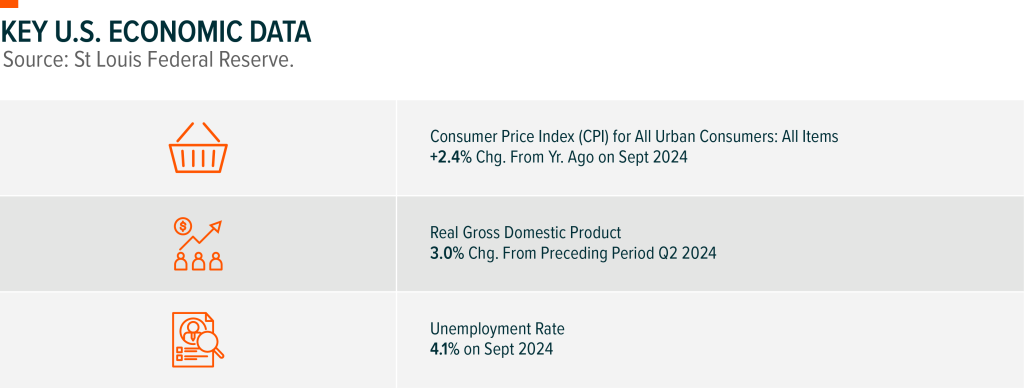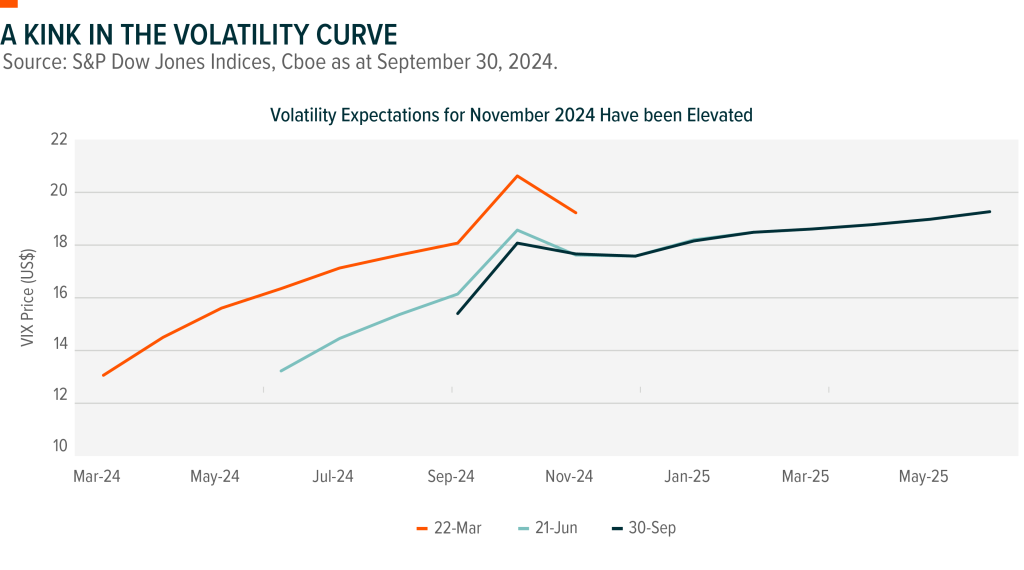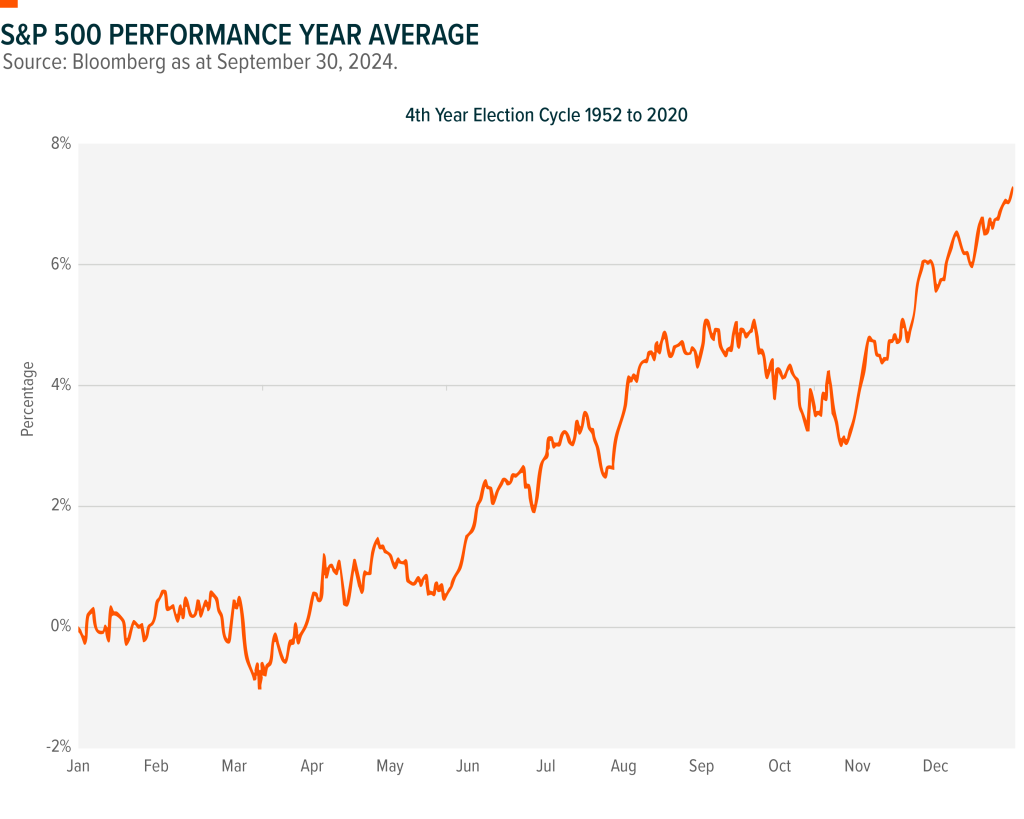
With the U.S. Presidential election in early November, this year’s road to The White House has seen some unexpected bumps along the way, including President Joe Biden’s decision not to stand for re-election, and two assassination attempts on the life of Republican candidate and former President Donald Trump.
With this backdrop, it’s no surprise that the market is bracing for higher volatility as election day – Tuesday, November 5, 2024 – approaches.
Let’s take a deeper look at how typical market conditions around Presidential elections could present opportunities for investors and how our Global X funds could offer a way to potentially capitalize on election-related volatility.
Economic Snapshot

After the first U.S. interest rate cut in four years – which was double the traditional quarter-point reduction – consensus is building that the U.S. could achieve a “soft landing”, that is a decline in inflation back to long-term averages amid a slowing (but not contracting) economy. Reducing inflation sustainably without sending the economy into recession is the balancing act that the U.S. Federal Reserve is trying to accomplish.
So far, so good, at least on that front. For the most part, the labour market appears healthy, with September’s non-farm payrolls report showing 254,000 jobs added, up from a revised 159,000 in August and better than previous forecasts.
As of September, the unemployment rate had fallen to 4.1% and average hourly earnings increased 4% from a year ago. At the same time, the latest U.S. CPI advanced 2.4% on a year-over-year basis, the smallest year-on-year rise since February 2021. However, risks to the soft-landing outcome remain. Declining consumer confidence could indicate a further economic slowdown ahead. This uncertainty around the future direction of the economy is exacerbated by another, larger unknown – the outcome of the Presidential election.
V for Volatility
One typical characteristic of U.S. elections is market volatility, preceding, during and often, after the event for a period of time. That volatility can worry investors and deter them from maintaining market exposure in fear of losses.
The VIX Index (“VIX”) is a real-time volatility index, created by the Chicago Board Options Exchange (CBOE). It was the first benchmark to quantify market expectations of volatility and on a global basis, is one of the most recognized measures of volatility. It is widely reported on by financial media and is closely followed as an indicator of market “health”. The index is a representation of the market’s expected volatility of the S&P 500 over the next 30 days. It is commonly used as a proxy for the entire U.S. stock market. The higher the expected volatility is, the more uncertainty there is about the future direction of the market. This is why the VIX is also known as the “Fear Index”, as it measures the level of market fear and stress. If we look at the VIX futures market (which measures the market’s expectations for the VIX into the future), we can see that the market has been anticipating elevated volatility around the election, since at least March of this year.

If we take a look at the past, this expectation of volatility appears to be a standard feature when we look at election years. You can see the average return of the S&P 500 during election years going back to 1950 here:

The overall trend that you can see from prior cycles is that we are generally going to see relative market growth during an election year. However, around October and November, there tends to be a dip that is typical heading into an election and the volatility associated with that can spook a lot of investors.
The market doesn’t like uncertainty. Uncertainty tends to exacerbate volatility. A closely matched election provides the ultimate event for an uncertain future, as market participants cannot appreciably anticipate policy decisions, since the make up of government going forward is unknown.
As well, this year there is a chance that the day after the election, we might not know who the winner is if certain polling districts recount votes or certain districts are closely contested. So, volatility can potentially linger a little bit further after the election and delay the trend that we see of a positive bump in the market after the dust settles. There are two things that might motivate investors to not fear volatility:
- Time in the market matters – staying consistently invested versus market timing usually yields better long-term results for investors.
- Some strategies offer the ability to maintain U.S. market exposure while also potentially reducing downside risk and taking advantage of volatility spikes to achieve greater income potential, through the use of options and covered call ETFs.
Despite the expectations of market volatility ahead, we think investors should stay invested in the market. It’s very hard to time the market as we all know: getting out at the right time, and getting back in at the right time as well.
One way to stay invested in the equity markets, but also potentially take advantage of that heightened volatility is by using a strategy, such as a covered call ETF.
These strategies can be a very easy way to tilt your portfolio, and stay invested in equity markets, but also take advantage of that heightened volatility. For those that aren’t familiar, covered calls refer to an investment strategy in which call options are sold on securities owned within a portfolio, allowing for the collection of premiums or income from the sale of the options contracts within the portfolio. Those option premiums are priced based on that expected volatility, and so can generate potentially higher premiums during periods of heightened volatility.
What Are Covered Call ETFs and How Do They Work?
Global X’s actively managed covered call ETFs aim to provide exposure to key equity benchmarks while generating additional income through covered calls. These ETFs seek to capture most of the upside potential of the underlying securities while offering attractive monthly income.
For income-focused investors, a covered call strategy can generate returns from assets that might otherwise fall short of income goals. For instance, the Nasdaq-100 and S&P 500 do not currently deliver dividend yields higher than 2%, as at September 30, 2024.
In contrast, covered call ETFs can provide income that is generally higher than simply holding the securities or investing in a fund that just replicates the index, and therefore, offers a way to meet income targets or diversify income sources, while maintaining exposure to the desired market segment.
It’s important to keep in mind that covered call ETF strategies typically trade some upside potential for the opportunity to achieve their monthly income from the sale of call options.
Global X’s actively managed covered call ETFs follow key investment rules to optimize performance. Equity-focused ETFs typically write shorter-dated (under two-month expiry), and generally out-of-the-money (OTM) covered calls.
This approach balances premium earnings with a higher likelihood of options expiring out-of-the-money. Covered calls are generally written on up to 50% of the underlying equities portfolio, allowing for the preservation of some upside potential. As a result, these ETFs are closely correlated with the underlying securities, offering a portion of their performance plus extra income from premiums. The risk profile remains similar to the underlying assets, with returns driven by price appreciation and option premiums.
Key Reasons to Consider Global X Covered Call ETFs
- Generate an Income Stream
All of our covered call ETFs seek to create additional income streams from the underlying securities in the portfolio by utilizing a dynamic covered call strategy
- Diversified Source of Income
Covered call ETFs offer income generation outside of fixed-income allocations, allowing investors to potentially boost portfolio income without increasing fixed-income contributions.
- Actively Managed
Experienced portfolio management team optimizes option pricing and adjusts coverage to benefit from market conditions.
- Reduced Volatility
Covered call ETFs correlate with market returns, but use call premiums to offset declines. As market volatility increases, so do option premiums, providing greater risk protection.
RELATED ETFs
USCC.U*, USCC – Global X S&P 500 Covered Call ETF
USCL – Global X Enhanced S&P 500 Covered Call ETF
QQCC – Global X NASDAQ-100 Covered Call ETF
QQCL – Global X Enhanced NASDAQ-100 Covered Call ETF
* Available in U.S. dollars.
DISCLAIMERS
Effective June 24, 2022, the investment objectives of the Global X S&P 500 Covered Call ETF (“USCC.U, USCC”) (formerly Horizons US Large Cap Equity Covered Call ETF), and the Global X NASDAQ-100 Covered Call ETF (“QQCC”) (formerly Horizons NASDAQ-100 Covered Call ETF), were changed following receipt of the required unitholder and regulatory approvals. For more information, please refer to the disclosure documents of the ETFs at www.GlobalX.ca.
Commissions, management fees, and expenses all may be associated with an investment in products (the “Global X Funds”) managed by Global X Investments Canada Inc. The Global X Funds are not guaranteed, their values change frequently and past performance may not be repeated. Certain Global X Funds may have exposure to leveraged investment techniques that magnify gains and losses which may result in greater volatility in value and could be subject to aggressive investment risk and price volatility risk. Such risks are described in the prospectus. The prospectus contains important detailed information about the Global X Funds. Please read the relevant prospectus before investing.
USCL and QQCL are alternative investment funds (“Alternative ETFs”) within the meaning of the National Instrument 81-102 Investment Funds (“NI 81-102”) and are permitted to use strategies generally prohibited by conventional mutual funds, such as the ability to invest more than 10% of their net asset value in securities of a single issuer, the ability to borrow cash, to short sell beyond the limits prescribed for conventional mutual funds and to employ leverage of up to 300% of net asset value. While these strategies will only be used in accordance with the investment objectives and strategies of the Alternative ETFs, during certain market conditions they may accelerate the risk that an investment in ETF Shares of such Alternative ETF decreases in value. The Alternative ETFs will comply with all requirements of NI 81-102, as such requirements may be modified by exemptive relief obtained on behalf of the ETF.
Certain statements may constitute a forward-looking statement, including those identified by the expression “expect” and similar expressions (including grammatical variations thereof). The forward-looking statements are not historical facts but reflect the author’s current expectations regarding future results or events. These forward-looking statements are subject to a number of risks and uncertainties that could cause actual results or events to differ materially from current expectations. These and other factors should be considered carefully and readers should not place undue reliance on such forward-looking statements. These forward-looking statements are made as of the date hereof and the authors do not undertake to update any forward-looking statement that is contained herein, whether as a result of new information, future events or otherwise, unless required by applicable law.
This communication is intended for informational purposes only and does not constitute an offer to sell or the solicitation of an offer to purchase investment products (the “Global X Funds”) managed by Global X Investments Canada Inc. and is not, and should not be construed as, investment, tax, legal or accounting advice, and should not be relied upon in that regard. Individuals should seek the advice of professionals, as appropriate, regarding any particular investment. Investors should consult their professional advisors prior to implementing any changes to their investment strategies. These investments may not be suitable to the circumstances of an investor.
The views/opinions expressed herein are solely those of the author(s) and may not necessarily be the views of Global X Investments Canada Inc. All comments, opinions and views expressed are generally based on information available as of the date of publication and should not be considered as advice to purchase or to sell mentioned securities. Before making any investment decision, please consult your investment advisor or advisors.
Standard & Poor’s®” and “S&P®” are registered trademarks of Standard & Poor’s Financial Services LLC (“S&P”) and have been licensed for use by Global X Investments Canada Inc. (“Global X”). The Global X ETFs are not sponsored, endorsed, sold or promoted by S&P, and S&P makes no representation, warranty or condition regarding the advisability of buying, selling or holding units/shares in the Global X ETFs.
Nasdaq®, Nasdaq-100®, and Nasdaq-100 Index® are trademarks of The Nasdaq Stock Market, Inc. (which with its affiliates is referred to as the “Corporations”) and are licensed for use by Global X Investments Canada Inc. The Product(s) have not been passed on by the Corporations as to their legality or suitability. The Product(s) are not issued, endorsed, sold, or promoted by the Corporations. THE CORPORATIONS MAKE NO WARRANTIES AND BEAR NO LIABILITY WITH RESPECT TO THE PRODUCT(S).
Global X Investments Canada Inc. (“Global X”) is a wholly owned subsidiary of Mirae Asset Global Investments Co., Ltd. (“Mirae Asset”), the Korea-based asset management entity of Mirae Asset Financial Group. Global X is a corporation existing under the laws of Canada and is the manager, investment manager and trustee of the Global X Funds.
© Global X Investments Canada Inc. All Rights Reserved.
For more information on Global X Investments Canada Inc. and its suite of ETFs, visit www.GlobalX.ca
Published October 25, 2024.
Categories: Articles, Insights
Topics: Covered Calls
